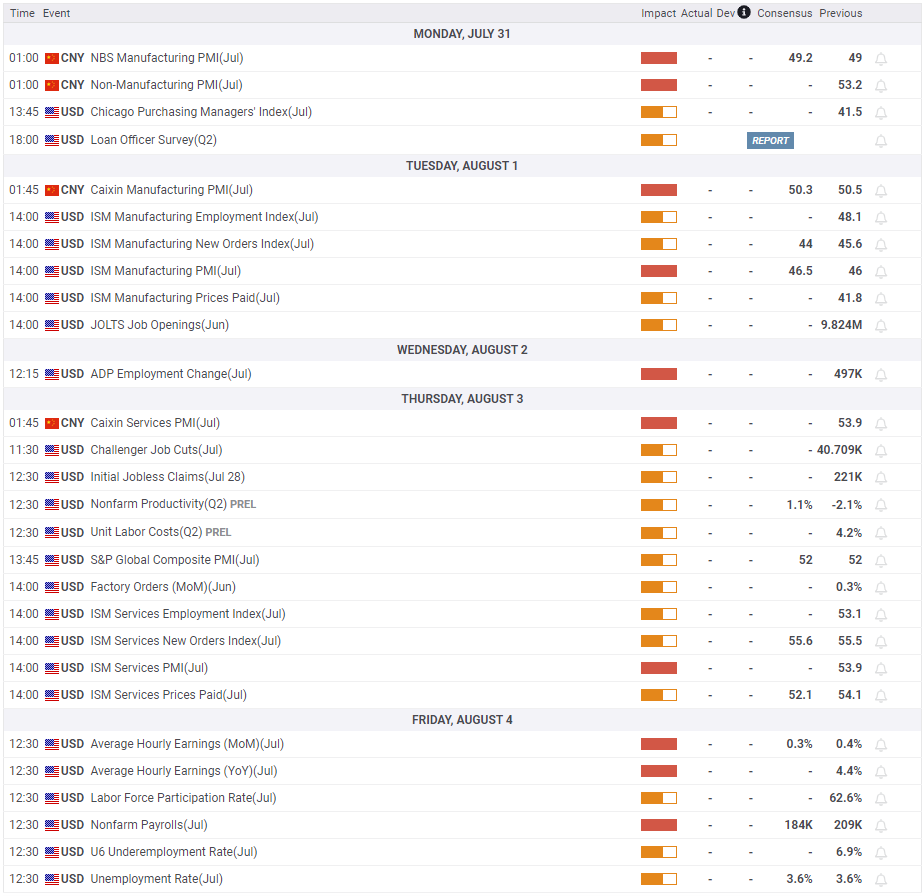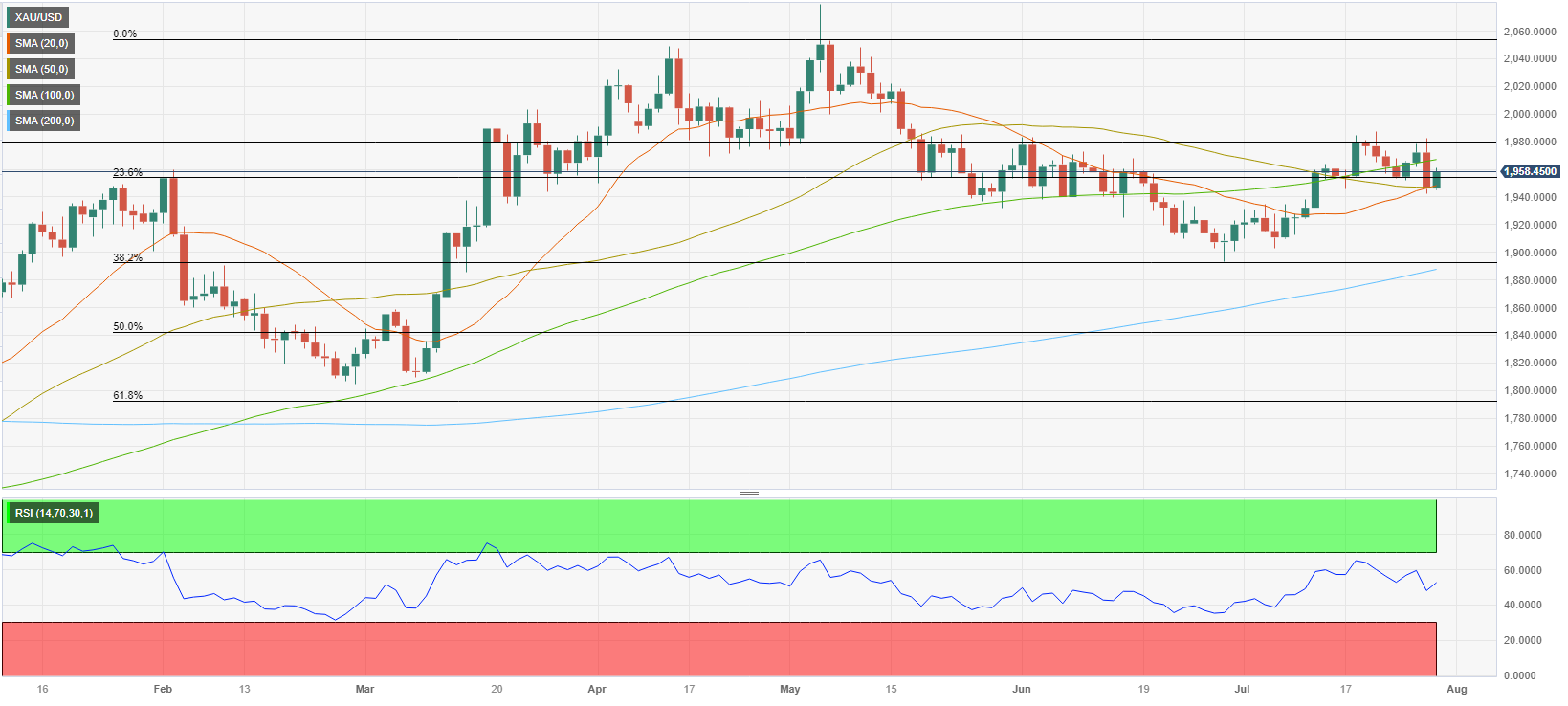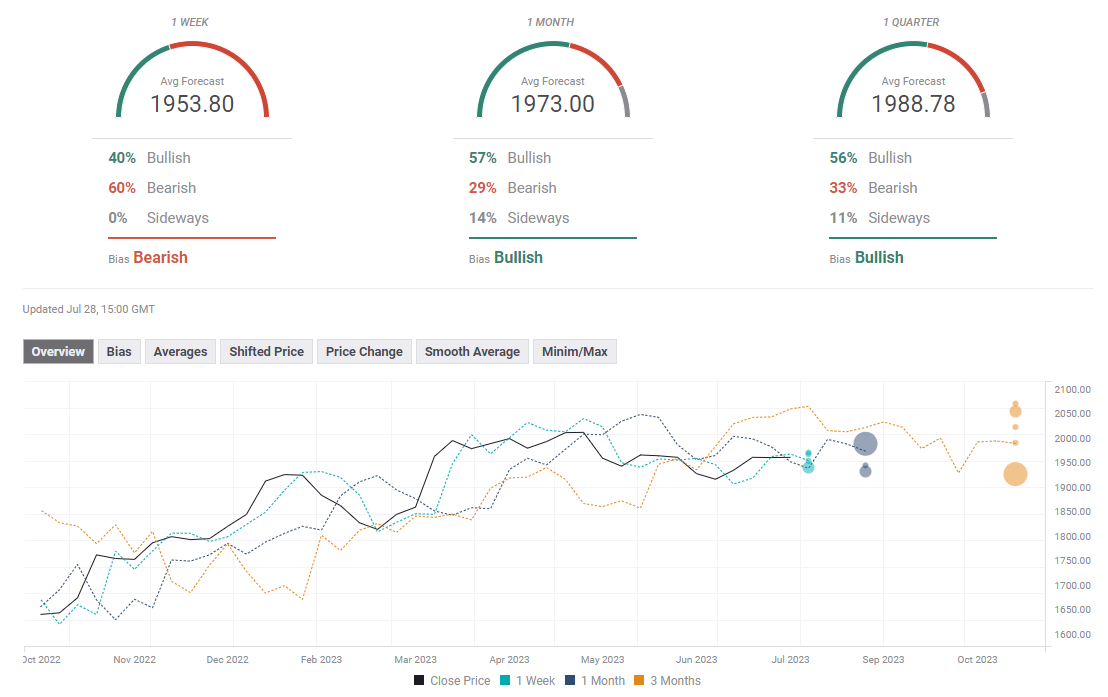- Gold price struggles to find direction despite volatile action in markets.
- XAU/USD continues to trade between key technical levels.
- July jobs report from the US will be the next big catalyst for the yellow metal.
Gold price made a U-turn in the second half of the week and dropped toward $1,950 after rising above $1,980 as upbeat data releases from the US pushed back against market expectations for a no-change in Federal Reserve policy rate for the rest of the year. XAU/USD, however, erased a large portion of its weekly losses on Friday as the US Dollar (USD) lost its appeal. July jobs report from the US could trigger the next big action in XAU/USD next week.
What happened last week?
Markets started the week in a quiet manner as participants refrained from taking large positions ahead of the Fed’s policy announcements. As the S&P Global PMI surveys showed that the US economy remained in a better shape than the Eurozone and the UK economy in June, the USD captured capital outflows out of the Euro and Pound Sterling. In turn, XAU/USD stayed under modest bearish pressure.
On Tuesday, the Conference Board’s monthly data revealed that the Consumer Confidence Index improved to 117.00 in July from 110.1 in June. The Present Situation Index climbed to 160.0 from 155.3 and the Consumer Expectations Index advanced to 88.3 from 80. These readings allowed the USD to hold its ground.
The Federal Reserve (Fed) raised its policy rate by 25 basis points to the range of 5.25-5.5% as expected following the July policy meeting. The US central bank made little to no changes to the policy statement when compared to June and failed to trigger a market reaction.
During the post-meeting press conference, Chairman Jerome Powell said the policy was already restrictive and refrained from confirming another rate hike later in the year, triggering a sharp decline in US Treasury bond yields. "If we see inflation coming down credibly, we can move down to a neutral level and then below neutral at some point," he further noted. As a result, XAU/USD gathered bullish momentum and climbed above $1,980.
On Thursday, however, the USD staged an impressive comeback, and the 10-year US Treasury bond yield surged above 4% following robust data releases from the US. Real Gross Domestic Product (GDP) of the US expanded at an annual rate of 2.4% in the second quarter, surpassing the market expectation for a growth of 1.8% by a wide margin. Additionally, Durable Goods Orders rose 4.7% in June, and weekly Initial Jobless Claims declined to 221,000 from 228,000. Investor sentiment quickly changed after the US data and markets reassessed the Fed’s rate outlook because Powell also said "stronger growth over time could add to inflation and may require a policy response” on Wednesday. Consequently, Gold price fell below $1,950 and erased all the post-Fed gains on Thursday.
Inflation in the US, as measured by the change in Personal Consumption Expenditures (PCE) Price Index, fell to 3% on a yearly basis in June from 3.8% in May, the US Bureau of Economic Analysis reported on Friday. Annual Core PCE Price Index, the Fed’s preferred gauge of inflation, grew by 4.1%, down from 4.6% in May. These data caused US T-bond yields to retreat ahead of the weekend and helped XAU/USD to retrace a portion of its weekly decline in the American session on Friday.
Next week
NBS Manufacturing PMI and Non-Manufacturing PMI data will be released from China, the world’s biggest consumer of Gold, in the early Asian session on Monday. A reading above 50 in Manufacturing PMI could help XAU/USD to start the week on a firm footing.
On Tuesday, the ISM Manufacturing PMI and JOLTS Job Openings data will be featured in the US economic docket. ISM Manufacturing PMI came in below 50 for the eighth straight month in June. Unless there is a significant decline toward 40, it shouldn’t come as a surprise if the PMI survey shows ongoing contraction in the manufacturing sector’s economic activity.
In his prepared remarks, Powell reiterated that labor demand was still substantially exceeding labor supply. A reading close to 10 million in JOLTS data could reaffirm tight labor market conditions and feed into hawkish Fed bets, causing XAU/USD to come under bearish pressure.
ADP private sector employment report and the ISM Services PMI will be released on Wednesday and Thursday, respectively. On Friday, the US Bureau of Labor Statistics will publish the July jobs report. Nonfarm Payrolls (NFP) are forecast to rise 184,000 in July following the 209,000 increase recorded in June. A reading close to 200,000 should be good enough for the Fed to consider additional tightening in the policy without worrying too much about a significant increase in the Unemployment Rate. If NFP arrives below 150,000, however, dovish Fed bets could weigh on yields and allow Gold price to push higher ahead of the weekend. Please note that the market expectation for NFP is subject to change approaching the release data.
To summarize, XAU/USD faces a two-way risk in the short term. A sudden downshift in US data could revive expectations for a no-change in the Fed’s policy rate this year and trigger a leg higher in Gold price. On the flip side, markets are likely to price in a stronger probability of one more rate hike in November or December if the US economy proves to be resilient and the labor market conditions remain tight. In that scenario, XAU/USD could find it difficult to shake off the bearish pressure.
Gold technical outlook
The Relative Strength Index (RSI) indicator on the daily chart started to edge higher after dropping to 50 on Thursday, suggesting that investors remain reluctant to bet on a steady decline in Gold price. On the upside, the 100-day Simple Moving Average (SMA) and the 20-week SMA form strong resistance at $1,970. Although XAU/USD closed above that level midweek, it failed to hold there. Hence, buyers could wait until that level is confirmed as support. In that case, $1,980 (static level) aligns as interim resistance ahead of $2,000 (psychological level, static level).
Looking south, an important support area is located at $1,945/$1,950, where the Fibonacci 23.6% retracement level of the long-term uptrend, 20-day SMA and 50-day SMA meet. If XAU/USD falls below that region and starts using it as resistance, sellers could take action, opening the door to an extended slide toward $1,920 and $1,900 (Fibonacci 38.2% retracement, 200-day SMA).
Gold forecast poll
FXStreet Forecast Poll points to a slightly bearish bias in the near term, with the average target aligning at $1,953. The one-month outlook remains bullish, with some of the polled experts seeing Gold price reaching $2,000 in that time frame.
Information on these pages contains forward-looking statements that involve risks and uncertainties. Markets and instruments profiled on this page are for informational purposes only and should not in any way come across as a recommendation to buy or sell in these assets. You should do your own thorough research before making any investment decisions. FXStreet does not in any way guarantee that this information is free from mistakes, errors, or material misstatements. It also does not guarantee that this information is of a timely nature. Investing in Open Markets involves a great deal of risk, including the loss of all or a portion of your investment, as well as emotional distress. All risks, losses and costs associated with investing, including total loss of principal, are your responsibility. The views and opinions expressed in this article are those of the authors and do not necessarily reflect the official policy or position of FXStreet nor its advertisers. The author will not be held responsible for information that is found at the end of links posted on this page.
If not otherwise explicitly mentioned in the body of the article, at the time of writing, the author has no position in any stock mentioned in this article and no business relationship with any company mentioned. The author has not received compensation for writing this article, other than from FXStreet.
FXStreet and the author do not provide personalized recommendations. The author makes no representations as to the accuracy, completeness, or suitability of this information. FXStreet and the author will not be liable for any errors, omissions or any losses, injuries or damages arising from this information and its display or use. Errors and omissions excepted.
The author and FXStreet are not registered investment advisors and nothing in this article is intended to be investment advice.
Recommended Content
Editors’ Picks

EUR/USD remains depressed near 1.1350
The US Dollar now grabs momentum and motivates EUR/USD to return to the 1.1350 zone on Thursday, as investors continue to digest the ECB’s decision to lower its policy rates by 25 basis points, as widely estimated. It is worth noting that most markets will be closed on April 18, Good Friday.

GBP/USD maintains the consolidation around 1.3260
The upside momentum in the British pound remains well and sound on Thursday, underpinning the eighth consecutive daily advance in GBP/USD, which now trades in a consolidative fashion near 1.326. Cable’s strong performance comes despite the marked rebound in the US Dollar.

Gold bounces off daily lows, back near $3,320
The prevailing risk-on mood among traders challenges the metal’s recent gains and prompts a modest knee-jerk in its prices on Thursday. After bottoming out near the $3,280 zone per troy ounce, Gold prices are now reclaiming the $3,320 area in spite of the stronger Greenback.

Crypto market cap fell more than 18% in Q1, wiping out $633.5 billion after Trump’s inauguration top
CoinGecko’s Q1 Crypto Industry Report highlights that the total crypto market capitalization fell by 18.6% in the first quarter, wiping out $633.5 billion after topping on January 18, just a couple of days ahead of US President Donald Trump’s inauguration.

Future-proofing portfolios: A playbook for tariff and recession risks
It does seem like we will be talking tariffs for a while. And if tariffs stay — in some shape or form — even after negotiations, we’ll likely be talking about recession too. Higher input costs, persistent inflation, and tighter monetary policy are already weighing on global growth.

The Best brokers to trade EUR/USD
SPONSORED Discover the top brokers for trading EUR/USD in 2025. Our list features brokers with competitive spreads, fast execution, and powerful platforms. Whether you're a beginner or an expert, find the right partner to navigate the dynamic Forex market.


